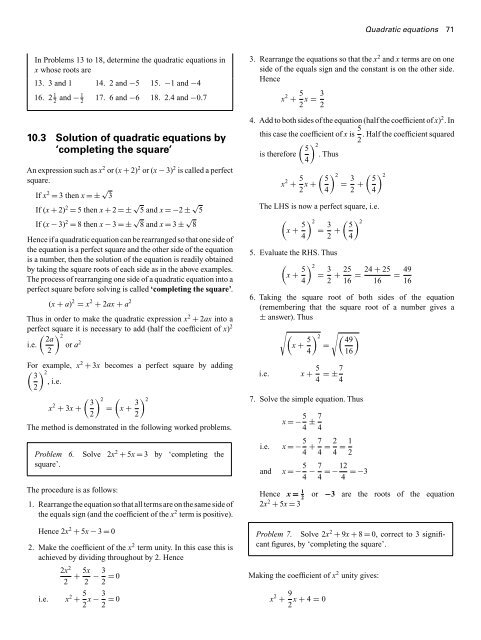basic_engineering_mathematics0
Create successful ePaper yourself
Turn your PDF publications into a flip-book with our unique Google optimized e-Paper software.
Quadratic equations 71<br />
In Problems 13 to 18, determine the quadratic equations in 3. Rearrange the equations so that the x 2 and x terms are on one<br />
i.e. x 2 + 5 2 x − 3 2 = 0 x 2 + 9 2 x + 4 = 0<br />
x whose roots are<br />
13. 3 and 1 14. 2 and −5 15. −1 and −4<br />
side of the equals sign and the constant is on the other side.<br />
Hence<br />
16. 2 1 2 and − 1 2<br />
17. 6 and −6 18. 2.4 and −0.7<br />
x 2 + 5 2 x = 3 2<br />
4. Add to both sides of the equation (half the coefficient of x) 2 .In<br />
this case the coefficient of x is<br />
10.3 Solution of quadratic equations by<br />
. Half the coefficient squared<br />
( ) 2<br />
‘completing the square’<br />
5 2<br />
is therefore . Thus<br />
4<br />
An expression such as x 2 or (x + 2) 2 or (x − 3) 2 is called a perfect<br />
square.<br />
If x 2 = 3 then x =± √ x 2 + 5 ( ) 5 2<br />
2 x + = 3 ( ) 5 2<br />
4 2 + 4<br />
3<br />
If (x + 2) 2 = 5 then x + 2 =± √ 5 and x =−2 ± √ 5<br />
The LHS is now a perfect square, i.e.<br />
If (x − 3) 2 = 8 then x − 3 =± √ 8 and x = 3 ± √ (<br />
8<br />
x + 5 ) 2<br />
= 3 ( ) 5 2<br />
Hence if a quadratic equation can be rearranged so that one side of<br />
4 2 + 4<br />
the equation is a perfect square and the other side of the equation 5. Evaluate the RHS. Thus<br />
is a number, then the solution of the equation is readily obtained<br />
(<br />
by taking the square roots of each side as in the above examples.<br />
x + 5 ) 2<br />
= 3 The process of rearranging one side of a quadratic equation into a<br />
4 2 + 25 24 + 25<br />
= = 49<br />
16 16 16<br />
perfect square before solving is called ‘completing the square’.<br />
6. Taking the square root of both sides of the equation<br />
(x + a) 2 = x 2 + 2ax + a 2<br />
Thus in order to make the quadratic expression x 2 + 2ax into a<br />
(remembering that the square root of a number gives a<br />
± answer). Thus<br />
perfect square it is necessary to add (half the coefficient of x)<br />
( ) 2<br />
√<br />
2a<br />
2 (<br />
i.e. or a 2<br />
x + 5 )<br />
√<br />
2 ( ) 49<br />
=<br />
2<br />
4 16<br />
For example, x 2 + 3x becomes a perfect square by adding<br />
( ) 3 2<br />
, i.e.<br />
2<br />
i.e. x + 5 4 =±7 4<br />
( ) 3 2 (<br />
x 2 + 3x + = x + 3 ) 2<br />
7. Solve the simple equation. Thus<br />
2<br />
2<br />
x =− 5 The method is demonstrated in the following worked problems.<br />
4 ± 7 4<br />
i.e.<br />
Problem 6. Solve 2x 2 + 5x = 3 by ‘completing the<br />
x =− 5 4 + 7 4 = 2 4 = 1 2<br />
square’.<br />
and x =− 5 4 − 7 4 =−12 4 =−3<br />
The procedure is as follows:<br />
Hence x = 1 2<br />
1. Rearrange the equation so that all terms are on the same side of 2x 2 + 5x = 3<br />
or −3 are the roots of the equation<br />
the equals sign (and the coefficient of the x 2 term is positive).<br />
Hence 2x 2 + 5x − 3 = 0<br />
Problem 7. Solve 2x 2 + 9x + 8 = 0, correct to 3 significant<br />
2. Make the coefficient of the x 2 term unity. In this case this is<br />
figures, by ‘completing the square’.<br />
achieved by dividing throughout by 2. Hence<br />
2x 2<br />
2 + 5x<br />
2 − 3 2 = 0<br />
Making the coefficient of x 2 unity gives:















![[Lonely Planet] Sri Lanka](https://img.yumpu.com/59845622/1/169x260/lonely-planet-sri-lanka.jpg?quality=85)

